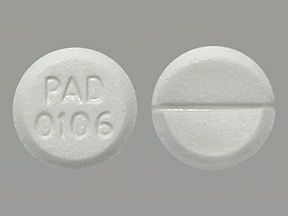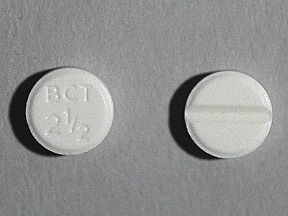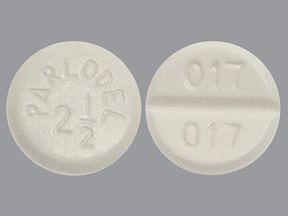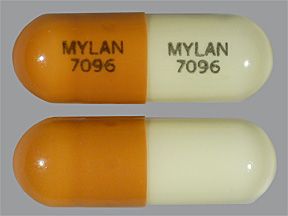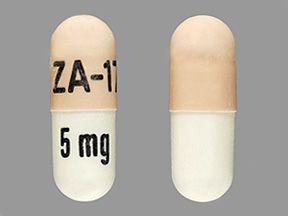Highlights for bromocriptine
- Bromocriptine oral tablet is available as a generic drug and as brand-name drugs. Brand names: Parlodel and Cycloset.
- Bromocriptine comes in two forms: an oral tablet and an oral capsule.
- The generic form of bromocriptine oral tablet and its brand-name version Parlodel are used to treat symptoms of Parkinson’s disease. They’re also used to treat symptoms of other conditions caused by very high levels of certain hormones. The brand-name version Cycloset is used to treat type 2 diabetes.
- Drowsiness warning: While taking bromocriptine, you may have sudden drowsiness, or fall asleep without warning. Avoid driving or using machinery until you know how this drug affects you.
- Low blood pressure warning: When first starting bromocriptine, you may have episodes of low blood pressure that can cause dizziness or fainting. These episodes occur more often when you stand after sitting or lying down. This is called orthostatic hypotension. To help prevent this, move slowly when changing positions.
- Heart attack, stroke, or seizure warning: In some cases, bromocriptine can cause heart attack, stroke, or seizures. The risk may be higher in women who have just given birth and take this drug to reduce the amount of milk they produce. It may also be higher in people with high blood pressure that is not well managed.
- Compulsive behaviors warning: Bromocriptine may cause intense urges to gamble, spend money, or binge-eat. It may also cause increased sexual urges or other intense urges. You may not be able to control these urges. Tell your doctor right away if you have any of these urges.
- Postpartum (recently given birth to a child) warning: Bromocriptine can cause serious and life threatening problems including high blood pressure, heart attack, seizures, stroke, and psychosis. If you have recently given birth, you should not take this medication.
Bromocriptine is a prescription drug. It comes in the form of a tablet and a capsule you take by mouth.
Bromocriptine oral tablet is available as the brand-name drugs Parlodel and Cycloset.
It’s also available as a generic drug. Generic drugs usually cost less than brand-name versions. In some cases, the brand-name drugs and the generic version may be available in different forms and strengths.
Bromocriptine oral tablet is often used as part of a combination therapy. This means you may need to take it with other medications. It can also be used in combination with surgery or radiation to treat certain conditions.
Why it’s used
Bromocriptine oral tablet is used to treat several conditions. The condition it treats depends on the form of the drug.
Parlodel and the generic bromocriptine oral tablet: These forms are used to help reduce symptoms of Parkinson’s disease, but they don’t cure it.
They also treat some conditions caused by high levels of certain hormones in the body, including prolactin and growth hormone. Bromocriptine reduces these hormone levels, which in turn treats the conditions.
Cycloset oral tablet: This form is used to help manage blood sugar levels in people with type 2 diabetes.
How it works
Bromocriptine belongs to a class of drugs called ergot derivatives. A class of drugs is a group of medications that work in a similar way. These drugs are often used to treat similar conditions.
Bromocriptine works in different ways, depending on the condition it’s being used to treat.
Parlodel and its generic form:
- Bromocriptine stimulates dopamine receptors in the brain. This helps to lessen symptoms of Parkinson’s disease and other parkinsonism disorders.
- Bromocriptine reduces the amount of the hormone prolactin that the body produces. Lowering the levels of this hormone helps treat galactorrhea (excessive lactation or milk production) or infertility. It also helps treat hypogonadism (a condition where the body doesn’t produce enough testosterone).
- Bromocriptine lowers levels of growth hormone in the body. This helps treat acromegaly, a condition that causes excessive growth of the hands, feet, and face. However, some healthcare professionals no longer use bromocriptine for acromegaly in clinical practice.
Cycloset:
- Cycloset lowers your blood sugar levels by boosting the action of dopamine, a chemical in the brain that sends messages between cells. Dopamine levels are often low in people with type 2 diabetes. By jump-starting dopamine, Cycloset helps make the body more effective at changing blood sugar to energy.
Bromocriptine oral tablet can cause dizziness and drowsiness during the first few hours after you take it. This happens more often when you first start treatment with the drug. Avoid driving or using heavy machinery if you have extreme drowsiness while taking this drug.
Bromocriptine can also cause other side effects.
More common side effects
The more common side effects that can occur with use of bromocriptine include:
- nausea
- headache
- stomach upset
- dizziness
- drowsiness
- feeling faint
- fainting
- suddenly falling asleep (most common in the treatment of Parkinson’s disease)
If these effects are mild, they may go away within a few days or a couple of weeks. If they’re more severe or don’t go away, talk with your doctor or pharmacist.
Serious side effects
Call your doctor right away if you have serious side effects. Call 911 if your symptoms feel life threatening or if you think you’re having a medical emergency. Serious side effects and their symptoms can include the following:
- Heart attack. Symptoms can include:
- chest pain
- shortness of breath
- discomfort in your upper body
- Stroke. Symptoms can include:
- weakness in one part or side of your body
- slurred speech
- Pulmonary fibrosis (scarring in the lungs). Symptoms can include:
- trouble breathing
- cough
- tiredness
- unexplained weight loss
- aching muscles or joints
- changes in the shape of the fingers or toes
Disclaimer: Our goal is to provide you with the most relevant and current information. However, because drugs affect each person differently, we cannot guarantee that this information includes all possible side effects. This information is not a substitute for medical advice. Always discuss possible side effects with a healthcare professional who knows your medical history.
Bromocriptine oral tablet can interact with other medications, vitamins, or herbs you may be taking.
An interaction is when a substance changes the way a drug works. This can be harmful or prevent the drug from working well.
To help avoid interactions, your doctor should manage all of your medications carefully. Be sure to tell your doctor about all medications, vitamins, or herbs you’re taking. To find out how this drug might interact with something else you’re taking, talk with your doctor or pharmacist.
Examples of drugs that can cause interactions with bromocriptine are listed below.
Antibiotics
When used with bromocriptine, certain antibiotics can increase the amount of bromocriptine in your body. This raises your risk for side effects from bromocriptine. Examples of these drugs include:
- erythromycin
- clarithromycin
HIV drugs
When used with bromocriptine, certain drugs used to treat HIV called protease inhibitors can increase the amount of bromocriptine in your body. This raises your risk for side effects from bromocriptine. Examples of protease inhibitors include:
- ritonavir
- lopinavir
- saquinavir
Psychiatric drugs
When used with bromocriptine, certain drugs used to treat psychiatric disorders can make bromocriptine less effective. This means it may not work well to treat your condition. Examples of these psychiatric drugs include:
- haloperidol
- pimozide
Other drugs
Metoclopramide is used to treat several conditions, including gastroesophageal reflux disease (GERD). Using this drug with bromocriptine can make bromocriptine less effective. This means it may not work well to treat your condition.
Taking ergot-related drugs, such as ergotamine and dihydroergotamine, with bromocriptine may cause an increase in nausea, vomiting, and fatigue.
It may also make these ergot-related drugs less effective when used to treat migraine. Ergot-related drugs should not be taken within 6 hours of taking bromocriptine.
Disclaimer: Our goal is to provide you with the most relevant and current information. However, because drugs interact differently in each person, we cannot guarantee that this information includes all possible interactions. This information is not a substitute for medical advice. Always speak with your healthcare professional about possible interactions with all prescription drugs, vitamins, herbs and supplements, and over-the-counter drugs that you’re taking.
This drug comes with several warnings.
Allergy warning
Bromocriptine can cause an allergic reaction. Symptoms can include:
- skin rash
- swelling of the tongue or throat
If you have an allergic reaction, call your doctor or local poison control center right away. If your symptoms are severe, call 911 or go to the nearest emergency room.
Don’t take this drug again if you’ve ever had an allergic reaction to it. Taking it again could be fatal (cause death).
Alcohol interaction warning
Bromocriptine can cause drowsiness or dizziness. The use of drinks that contain alcohol while taking this drug can make these symptoms worse.
Warnings for people with certain health conditions
For people with liver disease: It’s not known how safe or effective bromocriptine is for people with liver disease. Talk with your doctor about whether taking this drug is safe for you.
For people with kidney disease: It’s not known how safe or effective bromocriptine is for people with kidney disease. Talk with your doctor about whether taking this drug is safe for you.
For people with a history of psychosis: Bromocriptine can worsen psychotic conditions. Talk with your doctor about whether this drug is safe for you.
For people with a history of cardiovascular disease: Bromocriptine can worsen this condition. Talk with your doctor about whether this drug is safe for you.
For people with certain types of sugar intolerance: You shouldn’t take bromocriptine if you have certain types of sugar intolerance. These include galactose intolerance, severe lactase deficiency, or problems with absorbing certain types of sugars.
Warnings for other groups
For pregnant people: Parlodel is contraindicated in pregnancy. The manufacturer of Parlodel states that Parlodel should be discontinued when pregnancy occurs. In some cases, Parlodel may be restarted while an individual is pregnant to control a rapidly expanding macroadenoma.
If you experience a hypertensive disorder of pregnancy when receiving Parlodel, the benefit of continuing Parlodel must be weighed against the possible risk of its use during a hypertensive disorder of pregnancy.
You should talk with your doctor to weigh the benefits and risks of taking Parlodel during pregnancy.
Cycloset (the other brand name) and the generic bromocriptine do not carry this same warning.
Talk with your doctor if you’re pregnant or planning to become pregnant. Animal studies don’t always predict the way humans would respond. Therefore, this drug should only be used in pregnancy if clearly needed.
For postpartum people: Bromocriptine can cause high blood pressure, heart attack, seizures, stroke, and psychosis. If you have recently given birth to a child, you should not take this medication.
For people who are nursing: Bromocriptine may pass into breast milk and may cause side effects in a child who is nursed. Bromocriptine shouldn’t be used by gestational parents who are nursing.
For children: It hasn’t been established that Parlodel and generic bromocriptine are safe or effective to treat most conditions in children younger than 11 years.
It hasn’t been established that Cycloset is safe or effective for use in children younger than 16 years.
All possible dosages and drug forms may not be included here. Your dosage, drug form, and how often you take the drug will depend on:
- your age
- the condition being treated
- the severity of your condition
- other medical conditions you have
- how you react to the first dose
Dosage for hyperprolactinemia-associated disorders
Generic: Bromocriptine
- Form: oral tablet
- Strength: 2.5 mg
Brand: Parlodel
- Form: oral tablet
- Strength: 2.5 mg
Adult dosage (ages 16 years and older)
- Typical starting dosage: One-half to 1 tablet (1.25–2.5 mg) once per day.
- Increasing dosage: Your doctor may increase your dosage by 1 tablet every 2 to 7 days until your condition is controlled.
- Typical daily dosage: 2.5–15 mg once per day (in 2.5 or 5 mg tablets).
Child dosage (ages 11–15 years)
Prolactin-secreting pituitary tumor is the only condition that bromocriptine has been studied to treat in children younger than 16 years. Clinical trials in adults support the use of bromocriptine in children ages 11–15 years to treat this condition.
- Typical starting dosage: One-half to 1 tablet (1.25–2.5 mg) once per day.
- Increasing dosage: Your doctor may increase your child’s dosage as needed.
- Typical daily dosage: 2.5–10 mg once per day.
Child dosage (ages 0–10 years)
It hasn’t been confirmed that bromocriptine is safe and effective for people younger than 11 years in the treatment of hyperprolactinemia-associated disorders.
Dosage for acromegaly
Generic: Bromocriptine
- Form: oral tablet
- Strength: 2.5 mg
Brand: Parlodel
- Form: oral tablet
- Strength: 2.5 mg
Adult dosage (ages 16 years and older)
- Typical starting dosage: One-half to 1 tablet (1.25–2.5 mg) once per day at bedtime for the first three days.
- Increasing dosage: Your doctor may increase your dosage as needed every 3 to 7 days.
- Typical daily dosage: 20–30 mg once per day.
- Maximum daily dosage: 100 mg once per day.
Child dosage (ages 0–15 years)
It hasn’t been confirmed that bromocriptine is safe and effective for people younger than 16 years in the treatment of acromegaly.
Dosage for Parkinson’s disease
Generic: Bromocriptine
- Form: oral tablet
- Strength: 2.5 mg
Brand: Parlodel
- Form: oral tablet
- Strength: 2.5 mg
Adult dosage (ages 16 years and older)
- Typical starting dosage: One-half tablet (1.25 mg) twice daily with meals.
- Increasing dosage: Your doctor may increase your dosage by 1 tablet every 14 to 28 days as needed.
- Maximum daily dosage: 100 mg once per day.
Child dosage (ages 0–15 years)
It hasn’t been established that bromocriptine is safe or effective for people younger than 16 years in the treatment of Parkinson’s disease.
Dosage for type 2 diabetes
Brand: Cycloset
- Form: oral tablet
- Strength: 0.8 mg
Adult dosage (ages 16 years and older)
- Typical starting dosage: One 0.8-mg tablet taken once daily, with food, within 2 hours of waking in the morning.
- Increasing dosage: Your doctor may increase your dosage by 1 tablet once per week until you reach the appropriate dosage for you.
- Typical maintenance dosage: 1.6–4.8 mg taken once daily, with food, within 2 hours of waking in the morning.
- Maximum daily dosage: 6 tablets (4.8 mg) taken once daily, with food, within 2 hours of waking in the morning.
Child dosage (ages 0–15 years)
It hasn’t been established that Cycloset is safe or effective for children younger than 16 years.
Disclaimer: Our goal is to provide you with the most relevant and current information. However, because drugs affect each person differently, we cannot guarantee that this list includes all possible dosages. This information is not a substitute for medical advice. Always speak with your doctor or pharmacist about dosages that are right for you.
Bromocriptine oral tablet is used for short-term or long-term treatment. It comes with risks if you don’t take it as prescribed.
If you stop taking the drug suddenly or don’t take it at all: The condition you’re taking it for may not improve and may get worse.
If you miss doses or don’t take the drug on schedule: Your medication may not work as well or may stop working completely. For this drug to work well, a certain amount needs to be in your body at all times.
If you take too much: You could have dangerous levels of the drug in your body. Symptoms of an overdose of this drug can include:
- nausea
- vomiting
- constipation
- sweating
- dizziness
- low blood pressure (with symptoms such as confusion, dizziness, or blurry vision)
- extreme tiredness
- unusual yawning
- hallucinations (seeing or hearing things that aren’t there)
If you think you’ve taken too much of this drug, call your doctor or seek guidance from the American Association of Poison Control Centers at 1-800-222-1222 or through their online tool. But if your symptoms are severe, call 911 or go to the nearest emergency room right away.
What to do if you miss a dose: Take your dose as soon as you remember. But if you remember just a few hours before your next scheduled dose, take only one dose. Never try to catch up by taking two doses at once. This could result in dangerous side effects.
How to tell if the drug is working: The symptoms of your condition should improve.
Keep these considerations in mind if your doctor prescribes bromocriptine for you.
General
- Bromocriptine should be taken with food. This can help reduce side effects such as nausea.
- Take this drug at the time(s) recommended by your doctor. The time of day when you take bromocriptine depends on the reason you’re taking it. Your doctor or pharmacist will explain when to take this drug.
- You can cut or crush the tablet.
Refills
A prescription for this medication is refillable. You should not need a new prescription for this medication to be refilled. Your doctor will write the number of refills authorized on your prescription.
Travel
When traveling with your medication:
- Always carry your medication with you. When flying, never put it into a checked bag. Keep it in your carry-on bag.
- Don’t worry about airport X-ray machines. They can’t harm your medication.
- You may need to show airport staff the pharmacy label for your medication. Always carry the original prescription-labeled container with you.
- Don’t put this medication in your car’s glove compartment or leave it in the car. Be sure to avoid doing this when the weather is very hot or very cold.
Availability
Not every pharmacy stocks this drug. When filling your prescription, be sure to call ahead to make sure your pharmacy carries it.
Prior authorization
Many insurance companies require a prior authorization for this drug, especially for the brand-name versions. This means your doctor will need to get approval from your insurance company before your insurance company will pay for the prescription.
There are other drugs available to treat your condition. Some may be better suited for you than others. Talk with your doctor about other drug options that may work for you.
Disclaimer: Healthline has made every effort to make certain that all information is factually correct, comprehensive, and up to date. However, this article should not be used as a substitute for the knowledge and expertise of a licensed healthcare professional. You should always consult your doctor or other healthcare professional before taking any medication. The drug information contained herein is subject to change and is not intended to cover all possible uses, directions, precautions, warnings, drug interactions, allergic reactions, or adverse effects. The absence of warnings or other information for a given drug does not indicate that the drug or drug combination is safe, effective, or appropriate for all patients or all specific uses.

